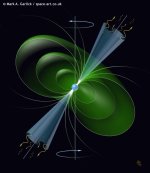First pulsars found in nederland
Thursday, February 12, 2009
The Amsterdam astronomy PhD student Gemma Janssen has three radio pulsars detected with the Westerbork Synthesis Radio Telescope in Dwingeloo. Pulsars are neutron stars, spheres neutron matter with a diameter of about twenty miles, following the death of heavy stars arise. These exotic objects have extremely strong magnetic fields from the magnetic poles are radio waves emitted beams, similar to the beam of a lighthouse. A total of 1800 pulsars are now known. The newly discovered pulsars are the first three from the Netherlands found.
The three pulsars were discovered with the new pulsar machine Puma II, in early 2006 has been used. The Westerbork radio telescope consists of fourteen separate dishes in a row. The dishes to be used as an interferometer can be very sharp images of, for example, large galaxies are made. For research to real point sources such as radio pulsars, were so far the signals of all dishes directly together. As the telescope is the high sensitivity required for detection of pulsars, but a very small horizon, which is disadvantageous when a large piece of the sky to afspeuren.
This' disadvantage 'of the Westerbork telescope to compensate Janssen has a new method, which several years ago under the direction of Smith co-supervisor Dr Ben Stappers developed. This method adds the incoming signals of twelve telescopes of the array using special software together. The result is a mosaic, where the large field of view of the small separate dishes combined with high resolution and sensitivity of the whole array - in this case similar to a dish of 74 meters diameter.
The complete article can be read on the website of the Netherlands Research School for Astronomy.
Thursday, February 12, 2009
The Amsterdam astronomy PhD student Gemma Janssen has three radio pulsars detected with the Westerbork Synthesis Radio Telescope in Dwingeloo. Pulsars are neutron stars, spheres neutron matter with a diameter of about twenty miles, following the death of heavy stars arise. These exotic objects have extremely strong magnetic fields from the magnetic poles are radio waves emitted beams, similar to the beam of a lighthouse. A total of 1800 pulsars are now known. The newly discovered pulsars are the first three from the Netherlands found.
The three pulsars were discovered with the new pulsar machine Puma II, in early 2006 has been used. The Westerbork radio telescope consists of fourteen separate dishes in a row. The dishes to be used as an interferometer can be very sharp images of, for example, large galaxies are made. For research to real point sources such as radio pulsars, were so far the signals of all dishes directly together. As the telescope is the high sensitivity required for detection of pulsars, but a very small horizon, which is disadvantageous when a large piece of the sky to afspeuren.
This' disadvantage 'of the Westerbork telescope to compensate Janssen has a new method, which several years ago under the direction of Smith co-supervisor Dr Ben Stappers developed. This method adds the incoming signals of twelve telescopes of the array using special software together. The result is a mosaic, where the large field of view of the small separate dishes combined with high resolution and sensitivity of the whole array - in this case similar to a dish of 74 meters diameter.
The complete article can be read on the website of the Netherlands Research School for Astronomy.


